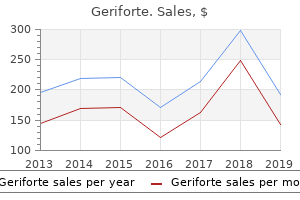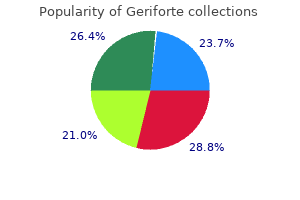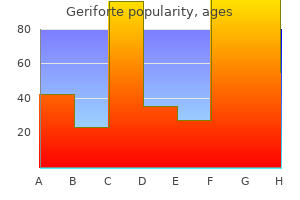CLINICAL,FORENSIC,AND ETHICS CONSULTATION IN MENTAL HEALTH
Geriforte
"Purchase 100mg geriforte free shipping, herbals on deck review".
By: K. Shawn, M.B.A., M.D.
Professor, Alpert Medical School at Brown University
In sufferers with concomitant middle ear effusion herbals man alive buy geriforte 100 mg mastercard, paracentesis must be carried out in the identical sitting or a ventilation tube must be inserted for drainage (see p vedantika herbals order geriforte 100mg. Benign Tumors Juvenile Angiofibroma Epidemiology: Benign tumors of the nasopharynx are uncommon herbs and rye purchase geriforte overnight delivery. The most typical of those is juvenile angiofibroma herbs books purchase geriforte online pills, which accounts for lower than 0. Symptoms: Typical signs are obstructed nasal respiration, recurrent epistaxis, headache, impaired eustachian tube air flow with center ear effusion, and conductive hearing loss due to obstruction of the eustachian tube orifice. Diagnosis: the standard endoscopic appearance is that of a well-circumscribed, vascularized mass. Preoperative embolization of the feeding vessels (usually the maxillary artery) should be performed to scale back the intensity of intraoperative bleeding. Symptoms: Early signs of nasopharyngeal malignancies are unilateral conductive hearing loss with middle ear effusion. Any persistent center ear effusion of long length in an adult affected person with no prior historical past of center ear disease is suspicious for a tumor and should be investigated accordingly. Cervical lymph-node metastasis, often involving the nodes on the mandibular angle, is one other widespread initial finding. Features of advanced disease embrace nasal airway obstruction, recurrent epistaxis, complications, and cranial nerve palsies. Malignant Tumors Epidemiology: Carcinomas of squamous-cell origin account for the great majority of malignant nasopharyngeal tumors. A fundamental distinction is drawn between squamous cell carcinomas and lymphoepithelial carcinomas (Schmincke tumor). Much less common tumors of this region are adenocarcinoma, adenoid cystic carcinoma, malignant melanoma. Nasopharyngeal malignancies can have a wide selection of appearances starting from a clean, well-circumscribed tumor floor to mucosal ulcerations. Otomicroscopy reveals unilateral tympanic membrane retraction and a center ear effusion because of impaired eustachian tube ventilation. Treatment: the remedy of choice for many nasopharyngeal carcinomas is primary high-voltage radiotherapy, as a outcome of most of those tumors are very radiosensitive and the unfavorable tumor location and fast invasion of the skull base preclude curative surgical procedure in plenty of cases. Nasal flooring c Tumor a Postrhinoscopic endoscopy demonstrates a mass that has obstructed the nasopharynx. Lesions of the oropharynx can also contribute to the development of sleep-related breathing issues, notably obstructive sleep apnea. Tumors, especially malignancies, are far much less widespread in this area however ought to still be considered in the differential prognosis, especially when sure risk components are present (heavy smoking, Injuries and Foreign Bodies Scalds and Corrosive Injuries Etiology: the unintentional ingesting of hot liquids by kids could cause extreme scalding of the lips, oral cavity, and oropharynx. Corrosive accidents are extra frequent in adults due to the ingestion of caustic liquids with suicidal intent. Symptoms: the dominant clinical signs are severe pain, especially on swallowing, and increased salivation. Subsequent blistering could occur, adopted by the formation of a whitish fibrin coating. Further tests are geared toward excluding injuries at lower ranges of the alimentary tract and within the mediastinum. A chest radiograph should all the time be obtained (to examine for mediastinal widening as a result of esophageal perforation). An early, cautious endoscopic examination can be performed so that the extent of the esophageal damage could be precisely assessed. Treatment: the initial remedy for scalds and corrosive accidents is to rinse the oral cavity with cold water. If the lips are affected, they need to be treated with a corticosteroid-containing ointment. Patients with extra extreme accidents can moreover be treated with systemic corticosteroids, antibiotics, and analgesics. Foreign Bodies Foreign our bodies in the oropharynx are mostly situated in the tonsils and at the tongue base. Treatment: the international materials ought to be removed as quickly as potential as a result of the danger of superinfection.

Either way rumi herbals pvt ltd discount 100 mg geriforte overnight delivery, the pores and skin nick could be enlarged with blunt hemostats quite than a blade herbs to grow indoors buy discount geriforte 100mg online, due to herbals choice 100mg geriforte overnight delivery elasticity of the pores and skin herbals wholesale discount geriforte 100 mg amex. Step-by-Step: Nontunneled Catheter Placement (Dermatotomy Enlargement) Step-by-Step: Nontunneled Catheter Placement (Transitional Dilator) (Left) If fluoroscopy is out there through the process, verify microwire location. Step-by-Step: Nontunneled Catheter Placement (Microdilator/Wire Removal) 112 Nontunneled Catheters Venous, Portal, and Lymphatic Procedures Step-by-Step: Nontunneled Catheter Placement (Guidewire Placement) Step-by-Step: Nontunneled Catheter Placement (Guidewire Visualization) (Left) A nonhydrophilic guidewire should advance easily through the microdilator into the central veins under fluoroscopic guidance. Step-by-Step: Nontunneled Catheter Placement (Tract Dilation) Step-by-Step: Nontunneled Catheter Placement (Catheter Insertion) (Left) the pores and skin tract is dilated over the guidewire. The dilator want be superior solely as deep as the vein, and definitely not further than the known distance of the guidewire. Advancing the dilator previous the top of the guidewire can result in mediastinal perforation and dying. This catheter advances over the guidewire similarly as would a dilator, but until the catheter is hubbed. Step-by-Step: Nontunneled Catheter Placement (Final Catheter Position) Step-by-Step: Nontunneled Catheter Placement (Final Catheter Position) (Left) the catheter is then flushed with saline or packed with heparin and secured to the skin with an adhesive system or suture, per hospital protocol. The optimum place for the Dacron cuff is in the course of the subcutaneous tunnel. A Dacron cuff on the catheter promotes tissue ingrowth throughout the tunnel, forming a barrier against infection. Continued pressure whereas advancing the needle permits puncture of the wall and lumen entry. This dilator has an inner part that accepts the microwire and an outer sheath that accepts a normal guidewire. The tunneler exits from the soft tissues instantly adjoining to the jugular venous entry sheath and guidewire. The tunnel should be of sufficient length that the cuff on the catheter lies no much less than 1-2 cm throughout the tunnel. After the internal dilator is eliminated, the tip of the adjoining catheter shall be introduced and shall be positioned just below the cavoatrial junction. Prior to dressing application, both lumina have been flushed, the catheter was secured to the pores and skin with purse-string sutures, and the venotomy was closed. Transhepatic and Translumbar Catheters Catheter-Induced Central Venous Occlusion (Right Brachiocephalic) (Left) Venogram shows right brachiocephalic vein occlusion from a prior proper hemodialysis catheter. The left-sided tunneled hemodialysis catheter was nonfunctional, doubtless due to the malpositioned tip. If this catheter is eliminated quite than exchanged, this entry route will be lost. Administering a thrombolytic agent through the lumen may restore patency if the catheter is occluded by thrombus. A fibrin sheath was current in the form of a catheter cast, extending into the proper atrium. This is a typical appearance of a port, with a metallic reservoir chamber, covered by an accessible silicon disc. The catheter is often cut to the suitable size previous to making this connection. Port Catheter Appropriate Appearance of Chest Port (Left) Radiograph reveals a single-lumen chest port with the catheter exhibiting a mild curve because it programs to point of venous entry into the internal jugular vein. This allows Huber needles to repeatedly penetrate the silicon cap of a port with out coring or chopping the silicone. Coady K et al: A comparison of infections and problems in central venous catheters in adults with strong tumours. Chest Port Insertion, Step-by-Step (Subcutaneous Pocket Creation) Chest Port Insertion, Step-by-Step (Subcutaneous Tunnel) (Left) the microwire is replaced with an 0. Then, an incision of enough length to accommodate the port is made in the anterior chest wall, 2-3 fingers width beneath the clavicle. Blunt dissection with a hemostat creates a subcutaneous pocket simply large sufficient for the port. The catheter should be instantly adjoining to the peel-away sheath with no intervening pores and skin.

It has been instructed that the inferior pulvinar nucleus receives fibres each from the superior colliculus and directly from the retina and that it contains a whole retinotopic representation herbal salvation purchase geriforte us. In essence herbals in the philippines order discount geriforte, the medial pulvinar nucleus projects to affiliation areas of the parietotemporal cortex herbals essences cheap geriforte express, whereas lateral and inferior pulvinar nuclei project to visible areas in the occipital and posterior temporal lobes herbals purchase geriforte overnight. Thus, the inferior pulvinar nucleus connects with the striate and extrastriate cortex in the occipital lobe and with visible association areas in the posterior part of the temporal lobe. The lateral pulvinar nucleus connects with extrastriate areas of the occipital cortex, posterior parts of the temporal association cortex and the parietal cortex. The medial pulvinar nucleus connects with the inferior parietal cortex, the posterior cingulate gyrus and widespread areas of the temporal lobe, together with the posterior parahippocampal gyrus and the perirhinal and entorhinal cortices. Similarly, the lateral pulvinar nucleus may connect with the rostromedial prefrontal cortex. The inferior pulvinar nucleus accommodates a complete retinotopic representation, and lateral and medial pulvinar nuclei additionally comprise visually responsive cells. Given the advanced features of the association areas to which they project, particularly in the temporal lobe. Anteriorly, the main subdivisions of the pulvinar blend into a poorly differentiated area within which several nuclear components have been acknowledged, together with the anterior or oral pulvinar, the suprageniculate limitans and the posterior nuclei. It is acknowledged that totally different parts obtain subcortical afferents from the spinothalamic tract and the superior and inferior colliculi. Cortical connections centre totally on the insula and adjacent elements of the parietal operculum posteriorly. Stimulation of this area has been reported to elicit ache, and enormous lesions may alleviate painful conditions. Similarly, excision of its cortical target within the parietal operculum, or small infarcts in this cortical region, could end in hypoalgesia. The intralaminar nuclei are collections of neurones within the internal medullary lamina of the thalamus. The anterior (rostral) group is subdivided into central medial, paracentral and central lateral nuclei. The posterior (caudal) intralaminar group consists of the centromedian and parafascicular nuclei. The centromedian nucleus is much larger, is significantly expanded in humans compared with other species and is importantly associated to the globus pallidus, deep cerebellar nuclei and motor cortex. Anteriorly, the inner medullary lamina separates the mediodorsal Lateral Dorsal Nucleus Lateral Posterior Nucleus Pulvinar Hippocampus Optic tract Crus cerebri. The vertical meridian is represented posteriorly, the peripheral anteriorly, the higher area laterally, and the decrease subject medially (Ch. Similar exact point-to-point illustration can be found within the projection of the lateral geniculate nucleus to the visual cortex. Radially arranged inverted pyramids of neurones in all laminae reply to a single small area of the contralateral visible area and project to a circumscribed area of cortex. The termination of geniculocortical axons within the visible cortex is taken into account in detail in Chapter sixteen. Aside from retinal afferents, the lateral geniculate nucleus receives a major corticothalamic projection, the axons of which ramify densely within the interlaminar zones. Other afferents embody fibres from the superficial layer of the superior colliculus (which terminate in the interlaminar zone between laminae 1 and 2 or 2 and three and round lamina S), noradrenergic fibres from the locus coeruleus, serotoninergic afferents from the midbrain raphe nuclei and cholinergic fibres from the pontine and mesencephalic reticular formation. The efferent fibres of the lateral geniculate nucleus pass principally to the first visible cortex (area 17) in the banks of the calcarine sulcus. It is possible that further small projections pass to extrastriate visual areas within the occipital lobe, probably arising primarily in the interlaminar zones. Intralaminar Nuclei 266 Chapter 15 / Diencephalon nucleus from the ventral lateral advanced. It is occupied by the paracentral nucleus laterally and the central medial nucleus ventromedially, as the two laminae converge towards the midline. A little extra posteriorly, the central lateral nucleus appears dorsally within the lamina because the latter splits to enclose the lateral dorsal nucleus. More posteriorly, on the stage of the ventral posterior nucleus, the lamina splits to enclose the ovoid centromedian nucleus. Thus, the central lateral nucleus initiatives mainly to parietal and temporal association areas, the paracentral nucleus to the occipitotemporal and prefrontal cortex and the central medial nucleus to the orbitofrontal and prefrontal cortex and to the cortex on the medial floor. Many cells all through the anterior nuclei have branched axons, which cross to both the cortex and the striatum.
Order geriforte 100 mg amex. FREE SAMPLE wholesale Blend Spice K2 replacement.
Feel for parotid enlargement herbals man alive purchase geriforte 100 mg without prescription, which may be present quickly after an acute alcoholic binge aasha herbals - generic 100 mg geriforte free shipping. Inspect the mouth with a torch and spatula for angular stomatitis herbs life order geriforte 100mg without prescription, ulceration and atrophic glossitis herbalsmokeshopcom discount geriforte 100 mg line. Ask the affected person to prolong his arms and arms and look for evidence of hepatic flap. The arthropathy of haemochromatosis may be current (a degenerative arthritis that particularly includes the second and third metacarpophalangeal joints). Ask whether you could additional examine for hernias by asking the patient to stand and cough. If you discover a pulsatile liver, study the cardiovascular system and significantly observe another indicators of tricuspid regurgitation. If malignant illness is suspected, look at all the node groups, the lungs and the breasts after a radical stomach examination. Non-haematological malignant disease that causes hepatomegaly not often leads to splenomegaly unless the portal vein is instantly concerned. Look for bruising, pigmentation, cyanosis, jaundice, scratch marks (due to myeloproliferative disease or lymphoma) and leg ulceration (see below). Also observe the presence of frontal bossing and the racial origin of the patient (thalassaemia is more widespread in individuals of Asian or Greek background). Look on the nails for koilonychia (spoon-shaped nails, that are rarely seen right now and which indicate iron deficiency) and the modifications of vasculitis. Pale palmar creases point out anaemia (usually the haemoglobin degree is < ninety g / L). The anterior conjunctiva ought to be distinctly redder in color except vital anaemia (<100 g / L) is current. Note any gum hypertrophy (the differential diagnosis consists of acute myeloid leukaemia � especially monocytic � and scurvy), ulceration, an infection. Candida), haemorrhage, atrophic glossitis (secondary to iron, vitamin B12 or folate deficiency) and angular stomatitis. There are seven groups: submental, submandibular, jugular chain, posterior triangle, postauricular, preauricular and occipital. There are 4 major areas: central, lateral (above and lateral), pectoral (most medial) and subscapular (most inferior). Inspecting the eyes, observe any jaundice, pallor or haemorrhage of the sclera, or the injected sclera of polycythaemia. Tap the backbone with your fist for bony tenderness (which could be caused by an enlarging marrow �. Ask to look at the legs from a neurological side for proof of vitamin B12 deficiency. Remember, hypothyroidism and lead poisoning could cause anaemia and peripheral neuropathy. Finally, ask to study the fundi (for engorged retinal vessels, papilloedema, haemorrhages, and so forth. Take time first to look at the face for signs of thyrotoxicosis or myxoedema (see level 7 below). With the affected person sitting up and the neck totally exposed, inspect for scars, swelling and outstanding veins. Palpate gently from behind, with the neck flexed, feeling for any thyroid mass (Table sixteen. If a nodule is palpable, determine whether or not this is single or part of a multinodular goitre. Ask the patient whether or not the gland is tender (a clue to subacute thyroiditis) and note any hoarseness of the voice (which may be brought on by recurrent laryngeal nerve palsy). Test the sternocleidomastoid perform, as malignant illness might infiltrate this muscle. Percuss over the higher a half of the manubrium from one aspect to the other, proper across the bone, and notice any change from resonant to dull (a sign of retrosternal extension). Auscultate over the thyroid gland for bruits (a signal of lively thyrotoxicosis) and also over the carotid arteries. Examine the eyes for exophthalmos by noting the presence of sclera below the cornea when the affected person is wanting straight ahead.

